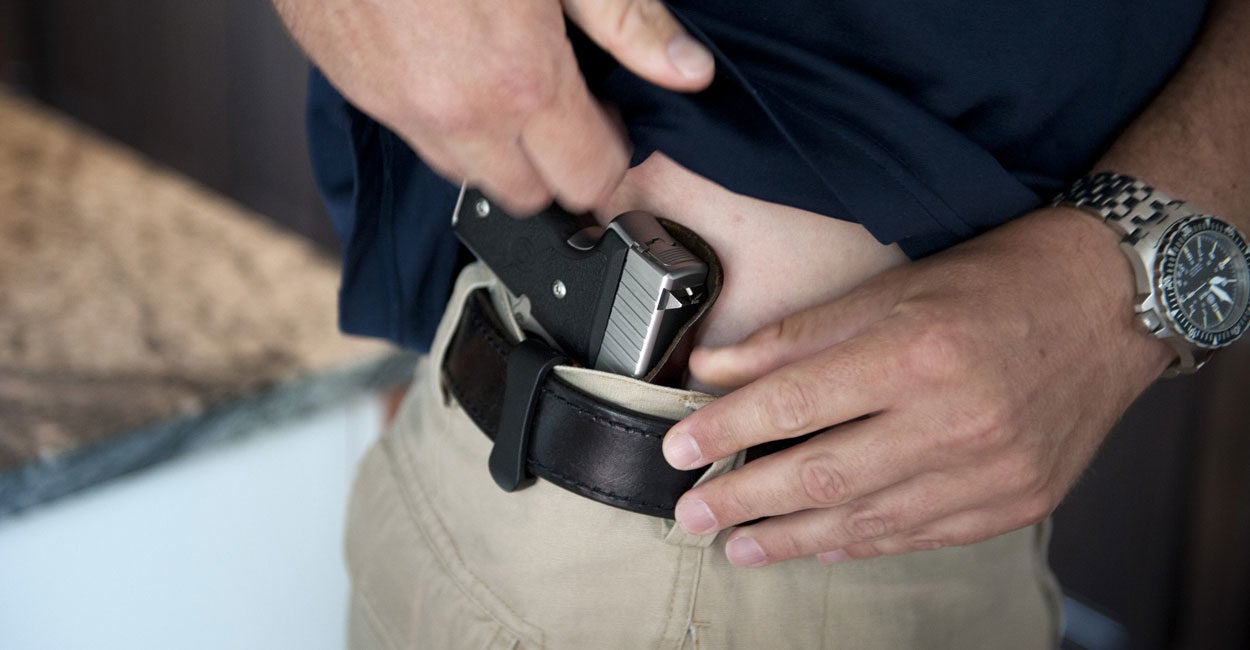When Charles McMahan agreed to talk with The Daily Signal about his program enabling trained teachers and other staff to carry guns in school, the Oklahoma school superintendent knew he’d be falling on the politically incorrect end of a sensitive conversation.
But as the educator who oversees more than 500 prekindergarten through 12th-grade students in the rural town of Porter, Oklahoma—40 minutes outside Tulsa—McMahan says he stands by his decision to arm qualified teachers and staff.
“My main job as superintendent is the safety of those kids,” McMahan told The Daily Signal in a phone interview.
The Daily Signal depends on the support of readers like you. Donate now
On a good day, law enforcement is 20 minutes away from the Porter Consolidated Schools district and its campus with multiple buildings, McMahan said. For that reason, he said, concealed carry permits for highly trained and qualified teachers and staff makes sense.
“In 20 minutes with an active shooter, it’s done,” McMahan said. “Seconds matter. Not minutes. So having somebody on campus that’s able to do this job and do it well—that’s important to me.”
Before the shooting at Marjory Stoneman Douglas High School in Parkland, Florida, that left 17 dead, the concealed carry program in Porter’s schools hardly was a topic among locals.
“The community loved it, everyone understood,” McMahan said.
Post-Parkland, though, with President Donald Trump advocating the arming of some teachers and many students, teachers, and politicians speaking against it, McMahan’s phone has been ringing off the hook.
Armed Educators (and trusted people who work within a school) love our students and will protect them. Very smart people. Must be firearms adept & have annual training. Should get yearly bonus. Shootings will not happen again – a big & very inexpensive deterrent. Up to States.
— Donald J. Trump (@realDonaldTrump) February 24, 2018
At least eight states already have programs allowing school faculty and other staff to carry concealed weapons on K-12 campuses, according to the Education Commission of the States. More states have introduced legislation to allow it, and a private, firearms training group called Faster Saves Lives says it has worked with 1,300 school staffers in 12 different states.
Concealed carry programs differ from state to state, and school district to school district. In Oklahoma, for example, lawmakers passed legislation in 2015 allowing school employees, including teachers, to carry guns on school grounds.
https://twitter.com/RepAsencio/status/968522436760293377
McMahan, 50, helped launch one of the first programs in the state at Okay Public Schools in Wagoner County, then replicated it at Porter Consolidated Schools, also in Wagoner, where he became superintendent last year.
When The Daily Signal interviewed him, McMahan said he had just finished a two-and-a-half-hour training session on a shooting range.
Porter’s school board is responsible for establishing requirements for the concealed carry program. McMahan said it’s “probably one of the most stringent” in the entire country.
For starters, the program requires that interested teachers and other school district employees take a Minnesota Multiphasic Personality Inventory test.
“They test to see if you’re crazy,” McMahan said, in non-politically correct terminology.
It also requires employees to have a valid license under the Oklahoma Self-Defense Act, and a valid license as an armed security guard or reserve peace officer, issued through Oklahoma’s Council on Law Enforcement Education and Training.
The course set up by the state agency involves qualification on a pistol range as required for all police officers in the state, including reserve officers and armed security guards. To pass, applicants must score a minimum of 72 out of a possible 100.
But for McMahan, a 72 wasn’t good enough.
“If I ever have to use this, I’m going to have a backdrop of students. And I can’t afford to hit a student,” McMahan said. “I’ve got to be able to hit the threat and put him down, and stop the killing immediately.”

In addition to his role at the Porter Consolidated Schools district, McMahan serves as a volunteer firefighter.
For that reason, McMahan said, he requires armed faculty to reach a proficiency rate of 80 percent on the field exam, eight points higher than the qualification required for Oklahoma police, sheriff, and highway patrol officers.
“To us, this is very serious. Your average police officer … when they’re out shooting, they won’t have a full backdrop of a school of students like I would,” the superintendent said. “So I feel like our requirements have to be higher.”
In the Okay school district where McMahan used to work, faculty who carry a firearm on school grounds are required to qualify three times a year. In Porter, McMahan requires participants to do the same.
In Oklahoma, law enforcement officers must qualify on firearms only once a year.
“It’s not just some fly-by-night thing that we’ve come up with, that anybody that wants to carry a concealed weapon can carry at school,” McMahan said. “We are highly trained, we’re pretty good at what we do.”
The names of those authorized to carry a firearm on school grounds are kept confidential at school and among the general public, but they are known to the school board and local law enforcement.
“We have to make sure they understand we’re not the bad guy, because we’re dressed in regular clothes,” McMahan said. “So part of our training is when somebody comes up behind you, what to do with the weapon.”
In Oklahoma, concealed carry programs on school grounds are young, and McMahan said he is always looking for ways to improve. And although he has the support of the community, the program is self-funded.
“The school’s not reimbursing me for anything when I’m on the gun range or for any of these classes—I’m using my own money and my own time to train myself to be able to protect these kids,” he said. “I just do what I can do.”
Ultimately, McMahan said, he would like to see other types of reforms to prevent and respond to active school shooters. But for now, he’s confident about what he’s doing.
“I look at every one of those kids as my own kids,” McMahan said. “I’ve got boy and girl twins at home, and I protect them with everything I’ve got at home. I’m going to protect my kids at school the same way. And if I’m empty-handed going up against an active shooter, I can’t protect them.”






























